Physical Address
304 North Cardinal St.
Dorchester Center, MA 02124
Obstructive disease in the renal arteries can decrease blood flow to the kidneys, which can result in activation of the renin-angiotensin system, hypertension, ischemic nephropathy, and other pathological changes. Technological advances, including intraarterial stenting, have generated enthusiasm for revascularization as a treatment for hypertension and progressive renal dysfunction caused by renal artery stenosis (RAS). However, there is no effect on mortality, and measurable beneficial outcomes (e.g., blood pressure [BP] improvement or stabilization of renal function) occur in only approximately 50% to 70% of patients who undergo successful revascularization, underlining the limited understanding of this disease and the importance of careful patient selection.
The predominant cause of obstructive RAS is atherosclerosis ( Fig. 58.1 ). The atherosclerotic process can involve the renal artery or the aorta, with disease of the latter affecting the ostium of the renal artery.
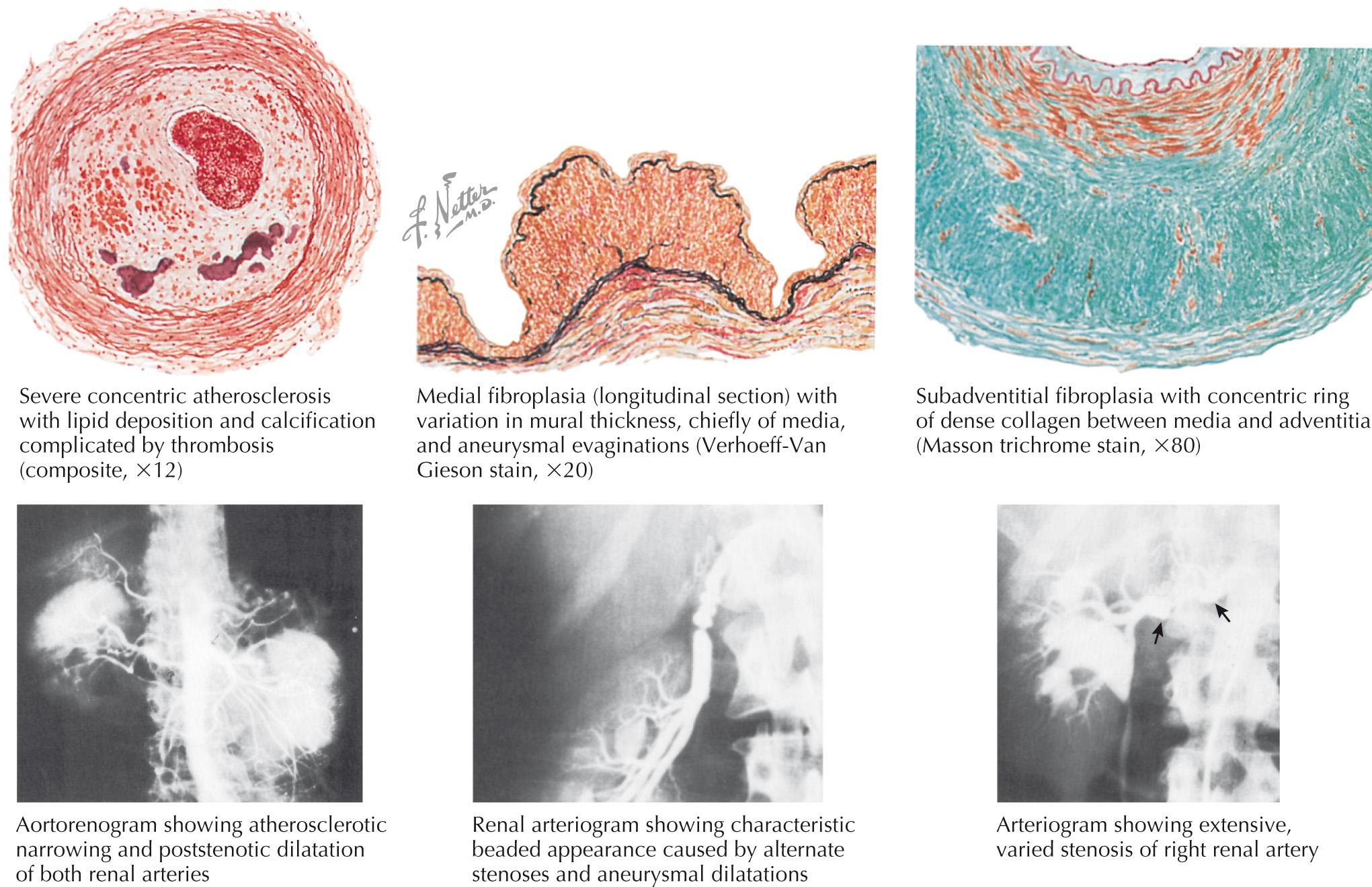
Obstructive RAS can also be caused by fibromuscular dysplasia (FMD), although this is rare and occurs in <10% of cases of RAS. FMD is a collection of vascular diseases characterized by intimal or medial hyperplasia. It is commonly bilateral and affects women more often than men. The middle and distal portions of the vessel are the most commonly involved sites, with a typical angiographic appearance of “beads on a string” (see Fig. 58.1 ). FMD can cause hypertension but rarely leads to major loss of renal function, although progressive renal impairment has been described in smokers with FMD.
Regardless of its underlying pathological cause, decreased renal perfusion results in compensatory activation of the renin-angiotensin system ( Fig. 58.2 ), which can cause systemic hypertension, salt retention, and activation of the neurohormonal system. RAS also causes ischemic changes within the kidney (ischemic nephropathy) and increased systemic markers of oxidative stress. Other pathological effects have been postulated but have not been proven to result from RAS.
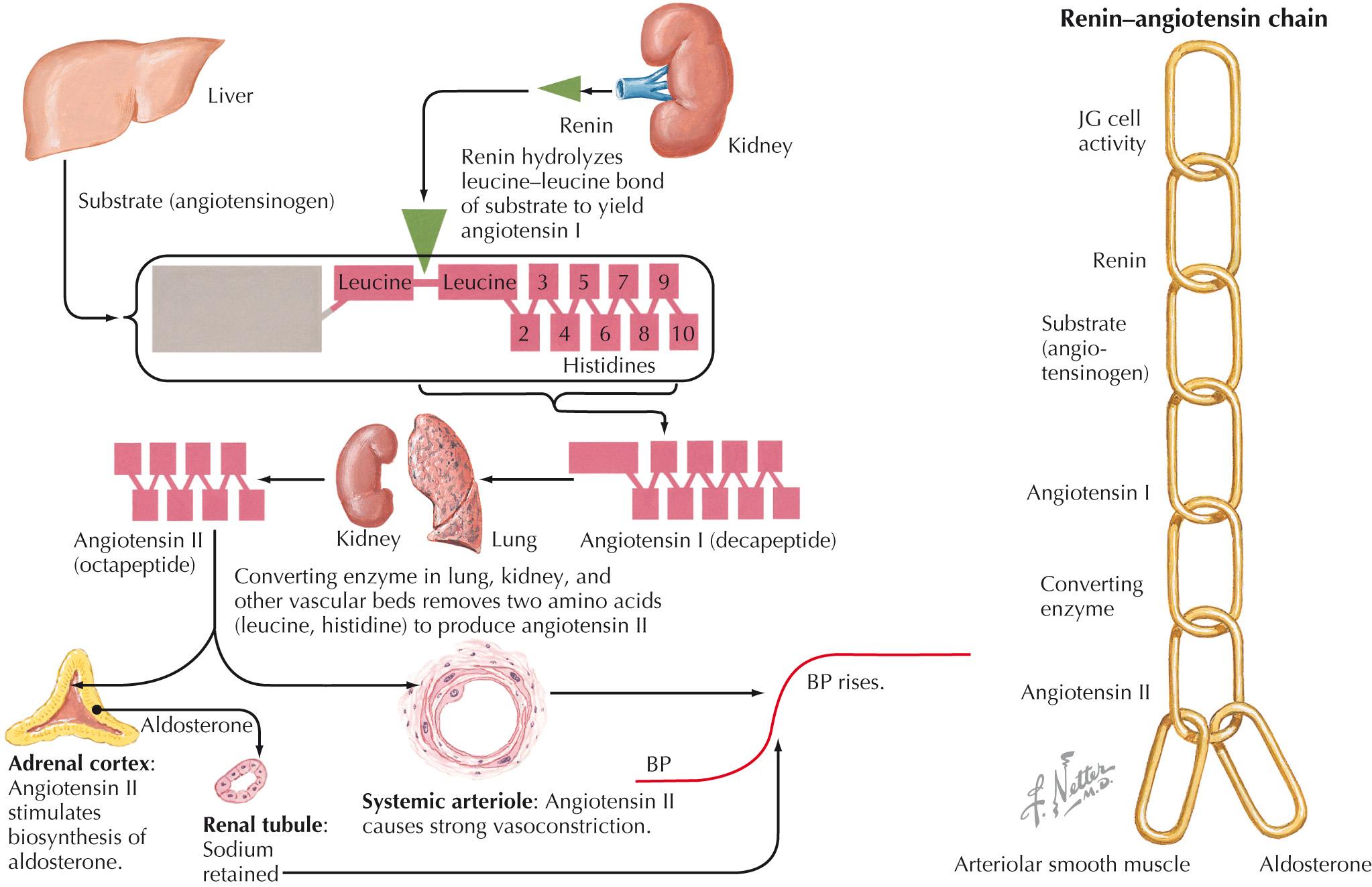
Hemodynamically significant RAS is associated with an increased incidence of major adverse cardiovascular events, including cardiac death, myocardial infarction, and stroke. In the Cardiovascular Health Study, a prospective, multicenter cohort study of Americans aged older than 65 years, the presence of renovascular disease, as determined by duplex ultrasonography, increased the risk of short-term adverse cardiovascular outcomes by approximately twofold. This risk persisted after controlling for coronary artery disease risk factors and existing cardiovascular disease, and was not dependent on the effects of increased BP. In other studies, 4-year survival was only 57% in patients with severe RAS discovered incidentally at the time of cardiac catheterization and 74% in a multicenter study of patients who underwent percutaneous renal revascularization. In a single-center study of 748 patients with severe renal artery disease who required percutaneous revascularization, 10-year survival was only 41%.
RAS is a progressive disease in which the rate of progression is a function of the disease severity and BP. Studies of patients with documented RAS have shown that progression of atherosclerotic disease in renal arteries occurs in approximately 25% of patients at 1 year, 35% at 3 years, and 50% at 5 years. The rate of progression to total occlusion at 5 years has been reported to be approximately 10% in arteries with lesions of <60% stenosis. In another study, in which the average stenosis at the time of enrollment was 72%, 16% of the patients randomly assigned to receive medical treatment had total occlusion at 1 year.
Most patients with hypertension have essential hypertension. Overall, renovascular disease is the etiology in 0.5% to 2% of patients with hypertension ( Fig. 58.3 ), but it is more common in patients who present with new-onset severe hypertension. RAS is more common in white than in black individuals, and the prevalence increases with age. Clinical factors that increase the likelihood of RAS include age, recent onset or sudden worsening of hypertension, and the presence of an abdominal bruit. The prevalence of RAS is also higher in patients with atherosclerosis in other vascular beds. Hemodynamically significant RAS is found in 6% to 23% of patients with hypertension who are undergoing cardiac catheterization. Significant RAS was found in 10.4% of patients at autopsy after a cerebrovascular accident.
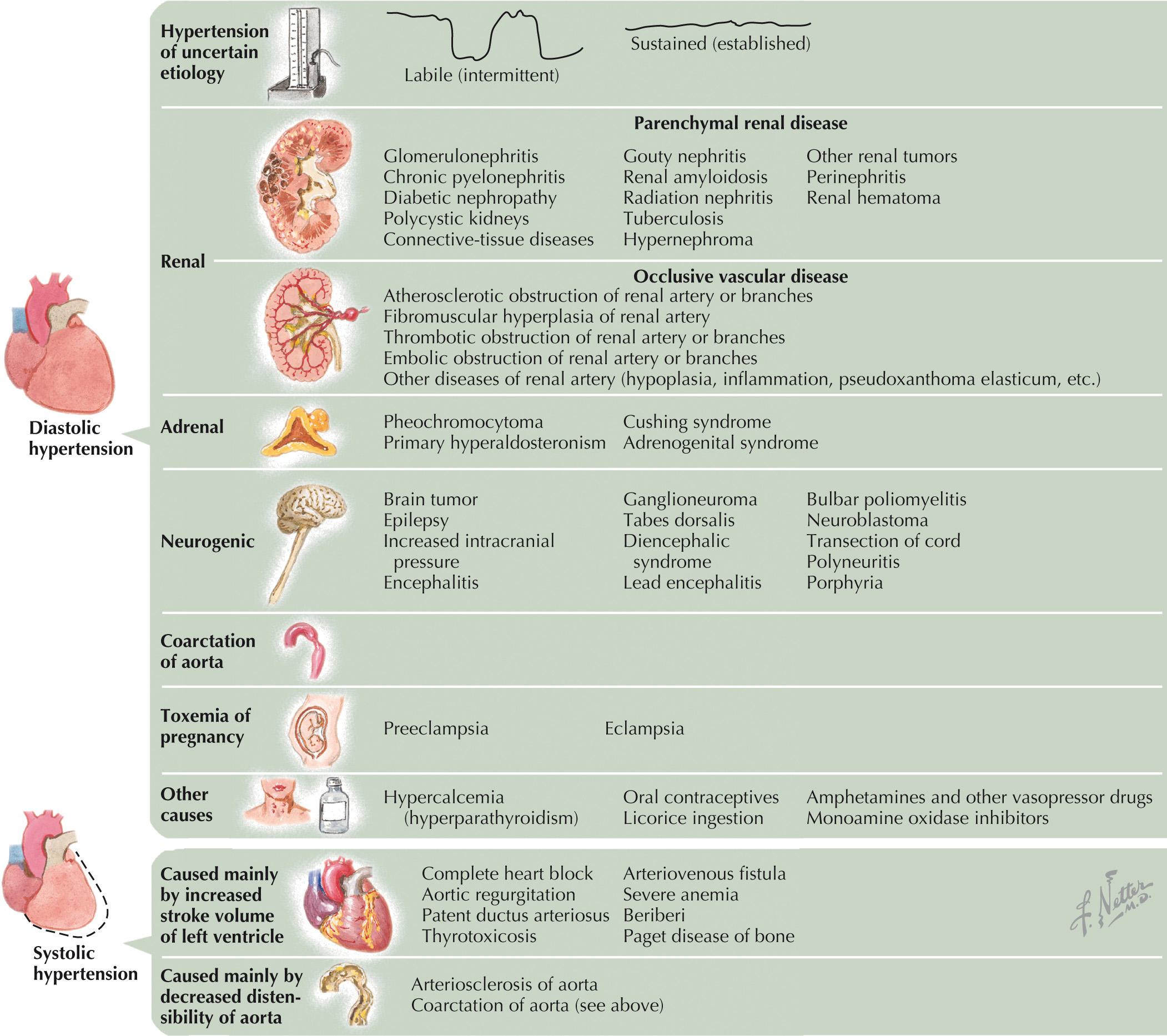
Atherosclerotic renovascular disease has been estimated to cause renal failure in 5% to 10% of Medicare patients who are starting dialysis for end-stage renal disease. The mortality in individuals with RAS and end-stage renal disease is staggering; survival rates reported at 2, 5, and 10 years are 56%, 18%, and 5%, respectively.
The American Heart Association Working Group for RAS has proposed that a grading classification for patients with RAS be used to facilitate trial design and reporting. Grade I is RAS plus no clinical manifestations (normal BP and renal function). Grade II is RAS plus medically controlled hypertension and normal renal function. Grade III is RAS plus uncontrolled BP, abnormal renal function, and/or evidence of volume overload.
The primary entity in the differential diagnosis is essential hypertension (see Chapter 15 ), although several other less common causes of hypertension must also be considered (see Fig. 58.3 ). The point at which renal artery atherosclerosis becomes physiologically significant and leads to increased BP and ischemic nephropathy is not completely understood. Recognition of lesions that compromise blood flow to the kidney is essential to identify patients whose conditions will improve with renal revascularization. This is especially important, because of the high rate of essential hypertension in patients with RAS.
There is as yet no consensus on how to identify significant RAS. In part this reflects that there is not a one-to-one correlation with stenosis severity and favorable outcomes after the stenosis has been reduced by percutaneous interventions. Although many surrogates have been proposed, one well-controlled study found that the only clinical factors that predicted a beneficial BP response to renal artery revascularization were a preprocedure mean arterial pressure >110 mm Hg and bilateral RAS. Other studies have indicated that measurement of split-vein renin levels may be a means to determine who will benefit from renal artery revascularization ( Fig. 58.4 ). A renal vein renin ratio of 1.5 : 1 correlates with BP improvement in some studies. Likewise, using captopril as a provocative agent coupled with nuclear imaging (scintigraphy) may be of value in identifying patients who will benefit from renal artery revascularization, with a sensitivity of approximately 75% and a specificity of 90%.
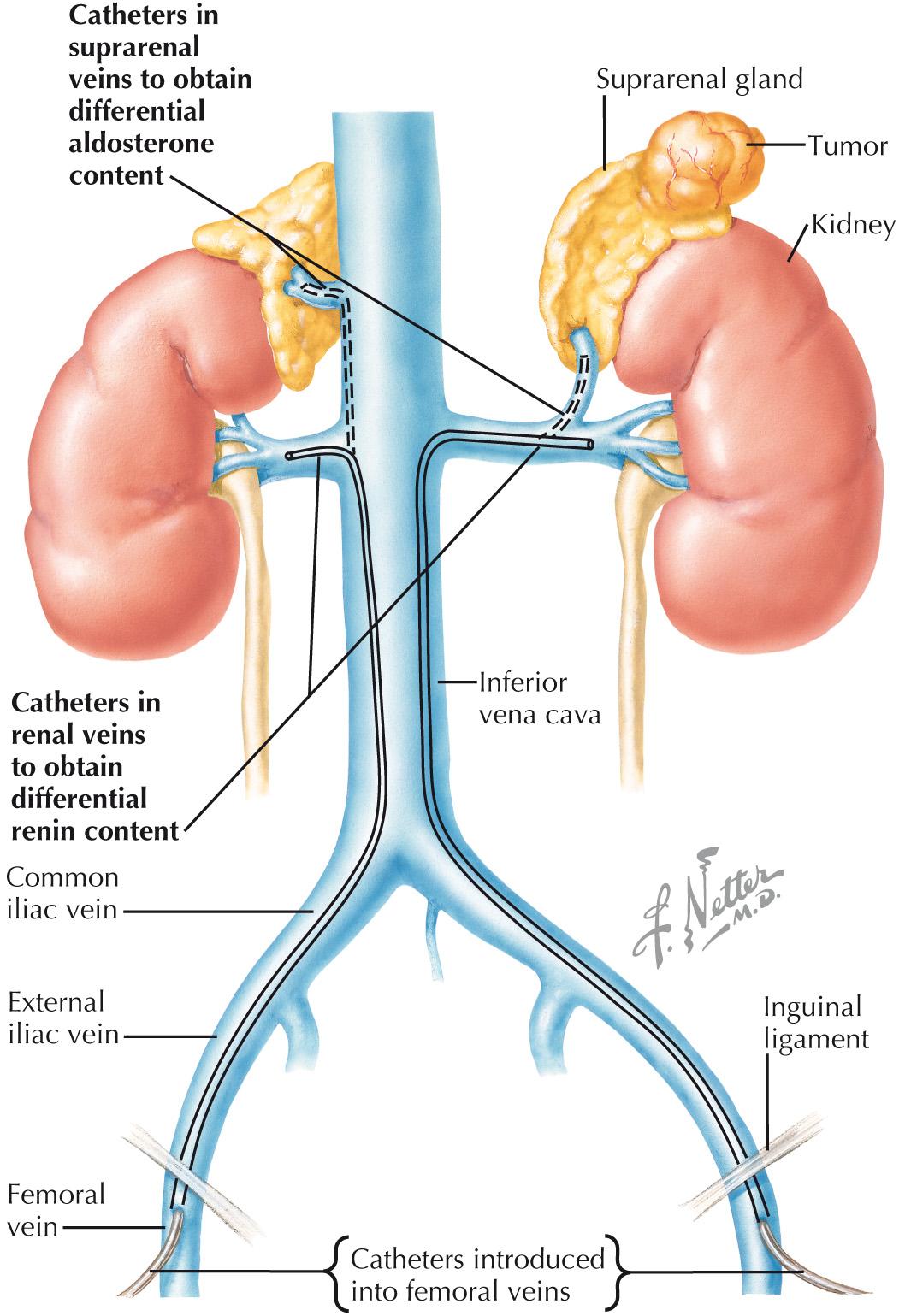
Doppler ultrasonography, although technologically demanding, is a promising technique. The measurement of a resistance index by Doppler can be used as a predictive tool. Patients with resistance index values >80 show much poorer results (no improvement in BP, worsening renal function) after revascularization than do patients whose values are <80. There is general agreement that lesions ≥70% by angiography are hemodynamically significant, whereas lesions ≤50% have no hemodynamic effect. The significance of lesions between 50% and 70% varies, leading some experts to advocate a measurement of translesional pressure gradients in these patients to determine hemodynamic significance. There are limited data that correlate translesional gradients to clinical outcomes, and there is no consensus on whether absolute systolic, peak systolic, or mean pressure should be used; whether the pressure should be measured during a resting or hyperemic state; and what level constitutes a lesion that would benefit from revascularization. Although not validated in large clinical studies or included in current guidelines, early work on renal fractional flow reserve (rFFR) has been promising in that it appears to have good predictive value relative to patient outcomes. rFFR is a proportional determinant of the severity of a stenosis by comparing the pressure distal to a stenosis with aortic pressure during hyperemia.
The renal arteries can be visualized with arteriography, magnetic resonance angiography (MRA), and spiral CT. Arteriography, with the direct injection of contrast dye into the renal artery, remains the gold standard for identifying and quantifying obstructive lesions ( Fig. 58.5 ). MRA and spiral CT are noninvasive methods with excellent sensitivity and good, but not optimal, specificity for identifying RAS.
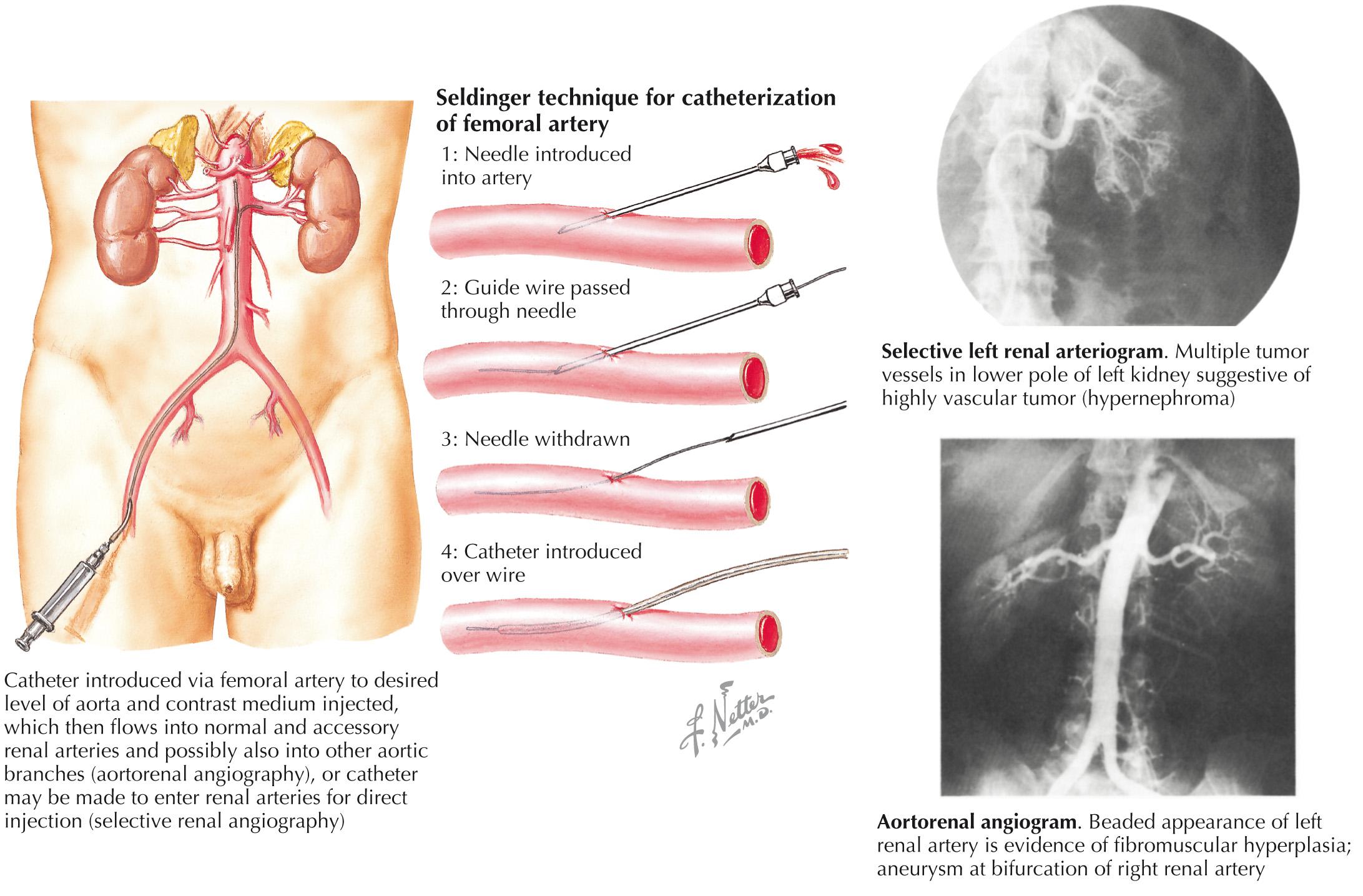
Become a Clinical Tree membership for Full access and enjoy Unlimited articles
If you are a member. Log in here